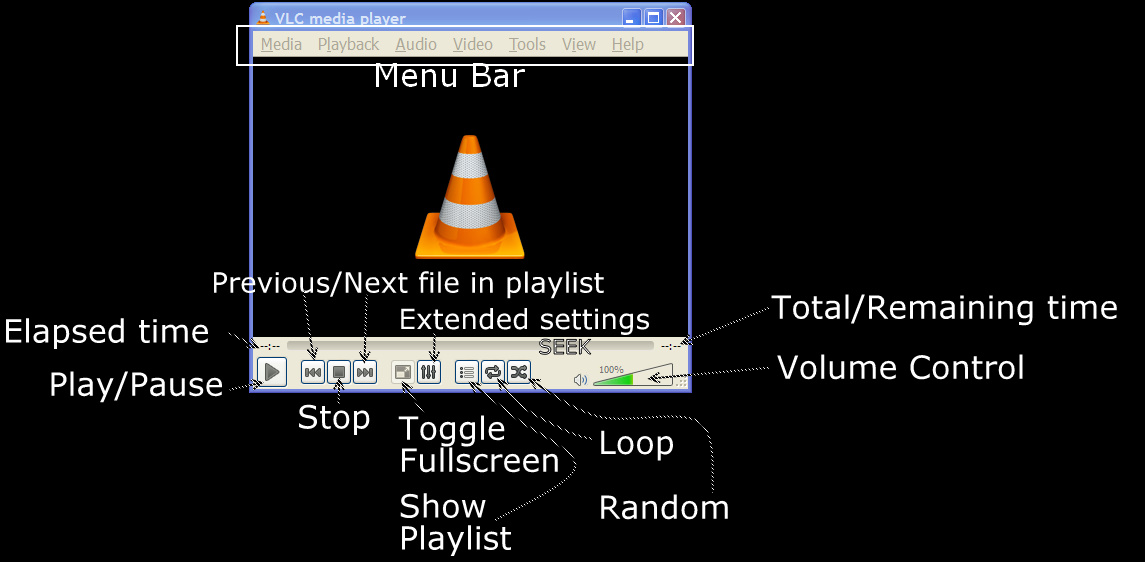Difference between revisions of "Documentation:VLC for dummies"
| Line 82: | Line 82: | ||
**Closing VLC | **Closing VLC | ||
***Windows<br> Right-click on the icon in the system tray and select '''Quit''' OR Click the Close[[Image:Close.png|27x29px]] button in the main interface of the application. | ***Windows<br> Right-click on the icon in the system tray and select '''Quit''' OR Click the Close[[Image:Close.png|27x29px]] button in the main interface of the application. | ||
| − | *Interface | + | **Interface overview<br> [[File:Interface1.png|800px]] |
| − | **elapsed time, remaining time | + | ***elapsed time, remaining time |
| − | **volume | + | ***volume |
| − | **fullscreen | + | ***fullscreen |
== See also == | == See also == | ||
Revision as of 00:26, 6 February 2012
Contents
VLC for dummies
Introduction
Thank you for visiting this page to find out what VLC is all about. Please Note: this page is Under Construction and might change in the near future.
VLC media player (or VLC for short) is a FREE and Open Source Software Media Player. Features that make VLC the preferred media player for a lot of people is its excellent support for various Audio and Video CODECs, the fact that it's cross platform and the open way of development.
This page will describe the steps to perform the basic steps of using VLC. For more Advanced Users see the VLC Play HowTo for a complete user guide, or VLC Streaming HowTo for the advanced streaming features that VLC is capable of.
Prerequisites
- Computer
- Audio output hardware (speakers, headphones) for audio playback
- Internet Browser (to download VLC)
- Internet Connection (for browsing to that dowload page)
- You know how to browse computer files and folders
- Media (audio,video) files or Disc (optical drive required to play discs)
Understanding the VLC interface
Windows notification area (system tray) Icon
When you start the VLC media player, the application appears on the screen and a small icon File:Vlc-win-taskbar.png appears in the notification area (system tray). Clicking once on the icon in the will hide the VLC media player, and clicking on it again will show it again. Hiding the icon does not close the application which continues to run in the background. By simply right clicking on this icon brings up a list of things to do: stopping or pausing playback or change track.
The main interface of VLC media player
Menu bar
The menu bar at the top contains commands accessible from the interface.
Track slider
![]()
The track slider is below the menu bar. It shows the progress of playing of the media file. You can drag the track slider left to rewind or right to forward the track being played. When a video file is played, the video appears between the menu bar and track slider.
Timers on each side show the elapsed time (left) and the total/remaining (right) time.
Note: When a media file is streamed (live), the track slider will not move because you are streaming at real time. Unlike a track which will end in a predetermined time.
Control buttons
The buttons below the slider help in controlling the playback.
From left to right:
- Play/Pause
- Previous Media in the Playlist
- Stop playback
- Next Media in the playlist
- Toggle the Video in fullscreen
- Show Extended Settings
Audio effects, Video effects, Synchronization - Show playlist
- Repeat: toggles between loop all, loop one, no loop (default)
- Random (Shuffle)
Plays the playlist randomly
Volume control
To the right of the control buttons is the volume control. The small speaker icon is a button to quickly mute![]() or un-mute
or un-mute![]() all sound. The slider to the right of it allows you to modify the volume to louder or softer. The percentage gives the amount of amplification.
all sound. The slider to the right of it allows you to modify the volume to louder or softer. The percentage gives the amount of amplification.
Tutorials
- Installing VLC
- Basics of VLC
- Windows
- starting VLC
Double click the VLC icon 32px on the desktop or from the start menu: select Programs, select VideoLAN and select VLC media player.
- starting VLC
- playing a media file stored in the computer
Click on the menu button on the top left of the program and choose one of the first four options, all of the options allow you to play media files.- Queuing files
You can queue files by selecting multiple files at a time
- Queuing files
- Playing from your optical reader (CD, DVD, Blu-Ray)
- Closing VLC
- Interface overview

- elapsed time, remaining time
- volume
- fullscreen
- Windows
See also
- Documentation:Play HowTo
- QtHotkeys (Qt is the default graphical interface)
- Hotkeys table
- How to set global hotkeys
- Windows Help and How-to
